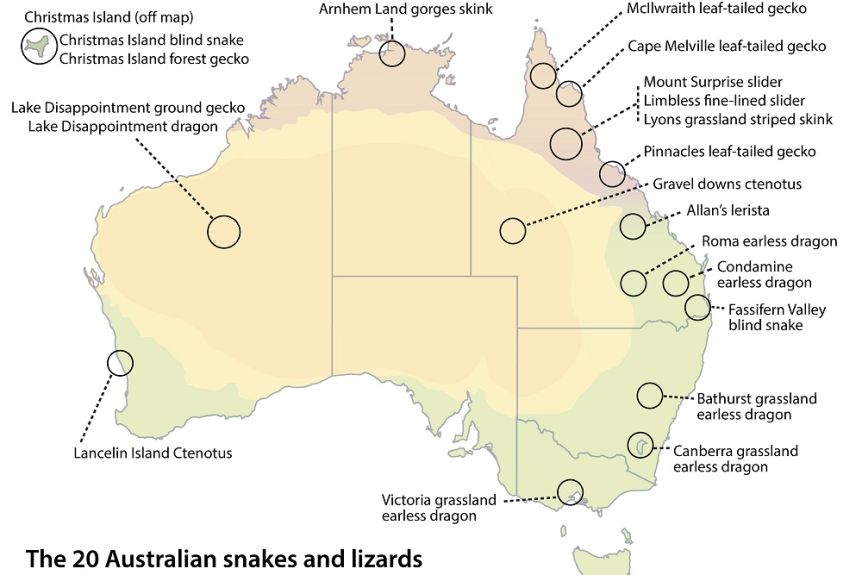https://www.abc.net.au/news/2020-09...iles-names-amid-calls-for-protection/12621740
Native geckoes at risk from poaching as scientists name Australia's most threatened reptiles
Rare Australian geckoes and lizards are being poached and sold on the black market, scientists warn, as they call for more action to protect endangered reptiles.
Key points:
They include the Victorian grassland earless dragon, the Fassifern blind snake, and the Arnhem Land gorges skink.
More than half of the animals are found in Queensland and many are not protected under Federal or state legislation.
Monash University associate professor David Chapple said the snakes, geckoes and lizards face a range of serious threats, including land clearing, climate change and poaching.
"There's been several instances where people have been caught collecting these species and they've been seen turning up on online marketplaces for sale," Dr Chapple said.
hidden in rice cookers destined for China, packaged without food or water to be sold on the black market.
'Cryptic' species not protected by law
Dr Chapple said while rare snakes and lizards were popular among collectors, there was a general lack of awareness about the threats they faced.
"I think the general public has a greater affinity with birds and mammals," he said.
"Lizards and snakes are generally very cryptic and hidden in the environment, and you really have to go out of your way to search for them."

Environmental scientists say Queensland is home to more than half the country's reptiles at highest risk of extinction.(Supplied: Threatened Species Recovery Hub)
He said half of the species most at risk of extinction were not listed as endangered or critically endangered under the Environment Protection and Biodiversity Conservation (EPBC) Act.
"There is still a lag from getting them from the international conservation ranking to being protected under Australian law," he said.
"That's partly a consequence of a lack of funding being devoted to many of these species, because they often occur in very remote and inaccessible places."
He said scientists were still coming to grips with the exact number of reptile species native to Australia.
"It's very hard to identify the conservation action for species when you don't even know if they exist or where they occur," he said.
Dr Chapple said more funding for research and monitoring of reptiles was needed.
Native geckoes at risk from poaching as scientists name Australia's most threatened reptiles
Rare Australian geckoes and lizards are being poached and sold on the black market, scientists warn, as they call for more action to protect endangered reptiles.
Key points:
- Australian scientists have identified the Australian reptiles most at risk of extinction
- Half are not protected under Australian law, despite being internationally recognised as endangered
- Major threats include climate change, land clearing and poaching
They include the Victorian grassland earless dragon, the Fassifern blind snake, and the Arnhem Land gorges skink.
More than half of the animals are found in Queensland and many are not protected under Federal or state legislation.
Monash University associate professor David Chapple said the snakes, geckoes and lizards face a range of serious threats, including land clearing, climate change and poaching.
"There's been several instances where people have been caught collecting these species and they've been seen turning up on online marketplaces for sale," Dr Chapple said.
hidden in rice cookers destined for China, packaged without food or water to be sold on the black market.
'Cryptic' species not protected by law
Dr Chapple said while rare snakes and lizards were popular among collectors, there was a general lack of awareness about the threats they faced.
"I think the general public has a greater affinity with birds and mammals," he said.
"Lizards and snakes are generally very cryptic and hidden in the environment, and you really have to go out of your way to search for them."

Environmental scientists say Queensland is home to more than half the country's reptiles at highest risk of extinction.(Supplied: Threatened Species Recovery Hub)
He said half of the species most at risk of extinction were not listed as endangered or critically endangered under the Environment Protection and Biodiversity Conservation (EPBC) Act.
"There is still a lag from getting them from the international conservation ranking to being protected under Australian law," he said.
"That's partly a consequence of a lack of funding being devoted to many of these species, because they often occur in very remote and inaccessible places."
He said scientists were still coming to grips with the exact number of reptile species native to Australia.
"It's very hard to identify the conservation action for species when you don't even know if they exist or where they occur," he said.
Dr Chapple said more funding for research and monitoring of reptiles was needed.



